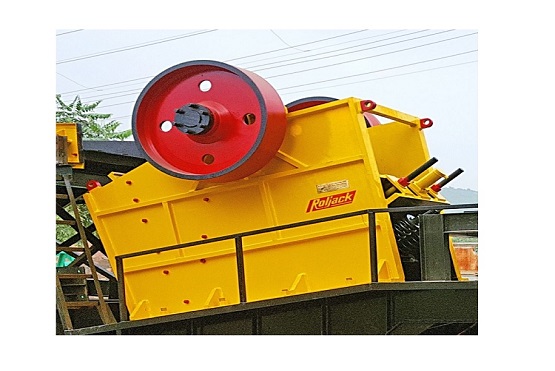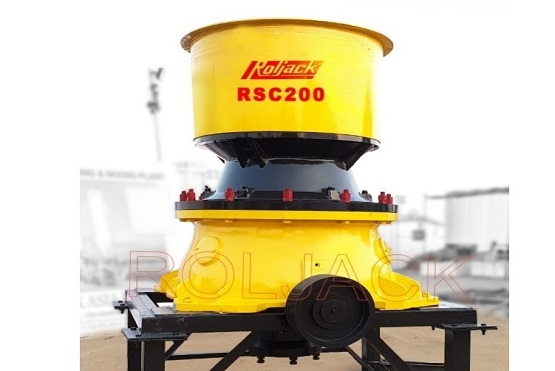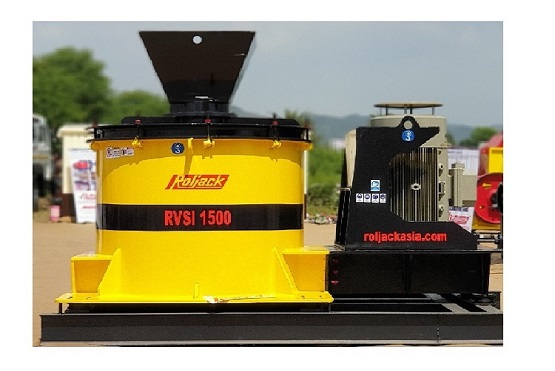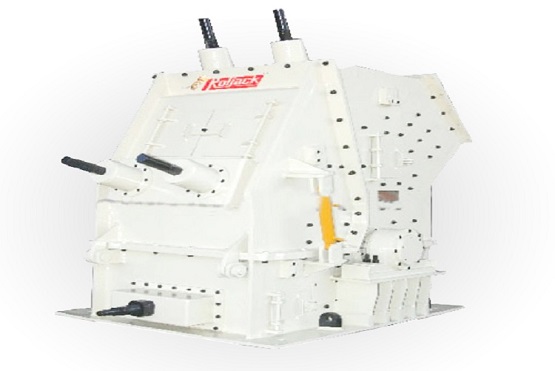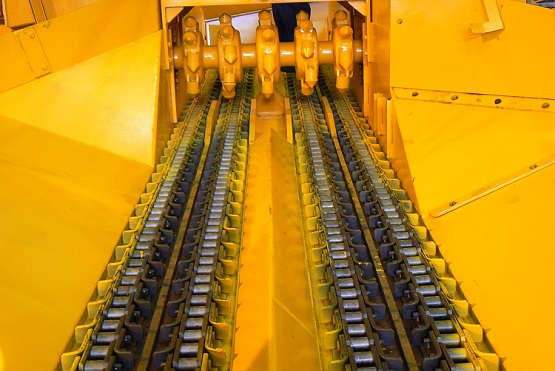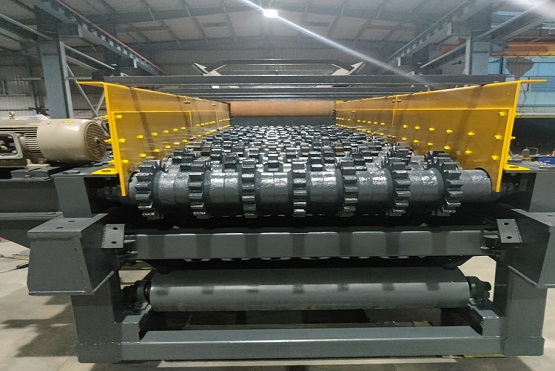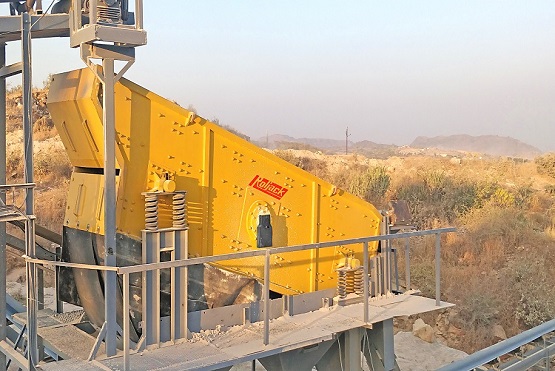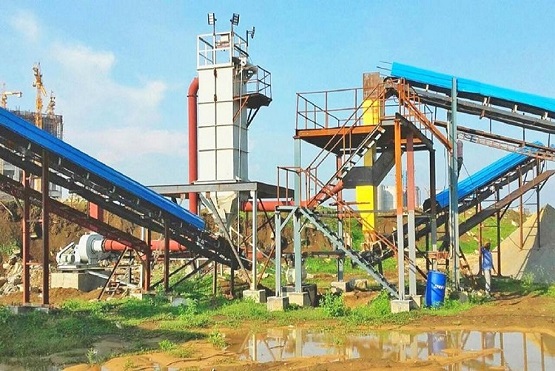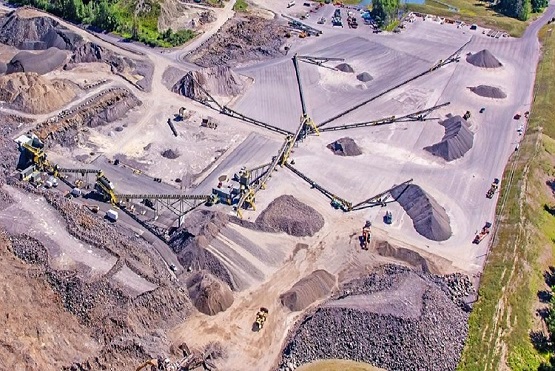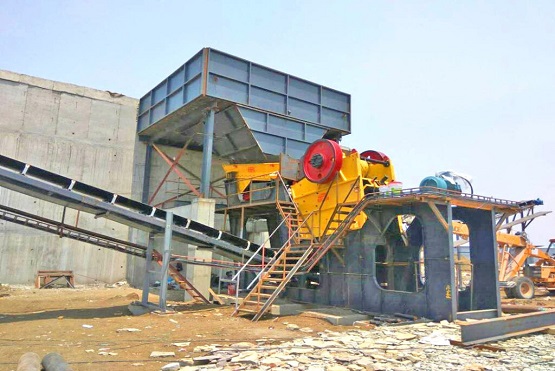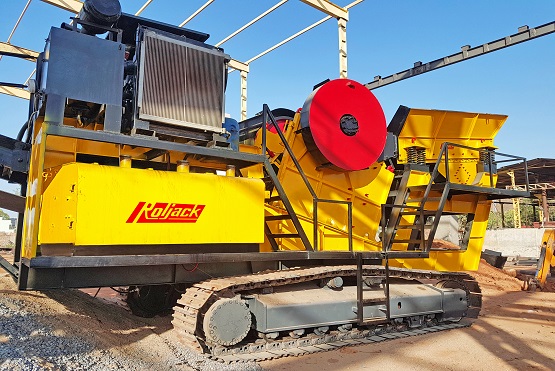-
What is crushing and screening process?
Crushing is an important mining process which involves the reduction of the particle sizes in an ore body after extraction. Along with crushing is the equally important screening that enables the separation of different sizes of particles.
-
Why toggle is used in jaw crusher?
The crushing force of the machine is made by an eccentric shaft and is transferred to the crushing zone by a toggle plate system. If uncrushable material enters the crusher chamber, the toggle plate is supposed to break to prevent overstressing the crusher.
-
What are jaw crusher used for?
Jaw crushers are mainly used as primary crushers. Their main purpose is to reduce the material to a small enough size that it can be transported by conveyors to the next crushing stages. As the name suggest, jaw crushers reduce rocand other materials between a fixed and a moving jaw.
-
How do you size a jaw crusher?
Jaw Crushers are sized by the top opening of the crushing chamber. For example, a 32 x 54 Jaw Crusher measures 32" from jaw die to jaw die at the top opening or gape opening and 54” across the width of the two jaw dies. The narrower bottom opening of the crushing chamber is used to size the discharge material.
-
What is the principle of jaw crusher?
The working principle of jaw crushers is based on the reciprocating movement of the movable jaw that compresses and crushes the rock or ore between itself and the fixed jaw, as the material enters the zone between the jaws.
-
What is crushing in mineral processing?
Crushing is the first step of mineral processing where the ore/rocks from the mine site is fed into the mechanical equipment in order to reduce the size of masses for subsequent usage by liberating the valuable mineral from the gangue.
-
What is stone crusher machine?
A crusher is a machine designed to reduce large rocks into smaller rocks, gravel, and sand or rock dust.
-
What is the best type of crusher?
Gyratory Crushers are an excellent choice for a primary crusher, as they can handle very hard and abrasive material. They are ideal for dry to slightly wet material but not sticky material. Gyratory are compression crushers primarily used for heavy mining and quarried materials in extremely high tonnage applications.
-
What determines the choice of a primary crusher?
The two main components to consider when identifying purpose are feed size and type of material to be crushed. There are a variety of other factors to review as well-the long-term strategy for the site, discharge gradation, moisture content of the material, and the targeted amount of production, just to name a few.
-
How do sand crushers work?
Impact crushers reduce mineral materials such as concrete, asphalt and natural rock in size to produce a valuable commodity product. A fast spinning rotor throws the material against a solid stationary impact wall. The striking and impacting causes the material to shatter into smaller pieces.
-
What is primary and secondary crusher?
Primary jaw crushers are typical of the square opening design, and secondary jaw crushers are of the rectangular opening design. A Jaw Crusher reduces large size rocks or ore by placing the rock into compression.
-
What are the three types of crushers?
Crushers are classified into three types based upon the stage of crushing they accomplish. These are (i) primary crusher, (ii) secondary crusher, and (iii) tertiary crusher.
-
How does a crusher machine work?
A jaw crusher consists essentially of two crushing plates, inclined to each other forming a horizontal opening by their lower borders. Material is crushed between a fixed and a movable plate by reciprocating pressure until the crushed product becomes small enough to pass through the gap between the crushing plates.
-
What is secondary crusher?
Crushing and pulverizing machines next in line after the primary crushing to further reduce the particle size of shale or other rock. All types of jaw crusher and gyratory crusher, and also crushing rolls, hammer mills, and edge runner mills.
-
What is the working principle of cone crusher?
Inside your cone crusher
The basic principle is straightforward: the material to be crushed (the feed), drops into the crushing chamber. The mantle is a moving part that gyrates in an eccentric motion.
-
How many types of cone crushers are there?
Inside your cone crusher
Cone crusher. With the rapid development of mining technology, the cone crusher can be divided into four types: compound cone crusher, spring cone crusher, hydraulic cone crusher and gyratory crusher.
-
What is the difference between jaw crusher and cone crusher?
The jaw crusher requires that the ore feeding must be even and not full, the materials in the jaw crusher chamber shall not exceed 2/3 of the crushing chamber height. The cone crusher can feed the ore with full load. It can be directly fed materials without vibration feeder.
-
What is the material used for crushing cone crusher?
Cone Crushers
They handle medium hard to very hard, abrasive materials that can be dry or wet but not sticky. Cone Crushers are typically found in quarried materials and sand and gravel application.
-
What is the efficiency of jaw crusher?
It is well known and taken for granted that the efficiency of energy use by comminution (i.e. breaking, crushing, grinding) equipment is very low, typically less than 10%. Most of the process input power is dissipated as heat and noise and ineffective deformation of the material to be processed and the device itself.
-
What is VSI aggregate?
Welcome to VSI SAND
It is a fine aggregate which is either natural or in the form of crushed stones and crushed gravel sand. It is finer than gravel and coarser than silt. Sand is a basic raw material used in the construction industries.
-
What is crushed sand?
Crushed sand is manufactured by crushing larger stones of quarry to particular size of sand. Its chemical & physical properties such as color, size & shape, surface texture up particles depend upon types of stone & its source The artificial sand produce by machine can be a better substitute to natural river sand
-
How do you know if your crush is good quality?
Calculation is simple, take the inner measurements of dumpers storage area, measure length, width and depth with a help of steel road. Depth should be measured carefully only up to the extent at which sand is present. If measurements comes out in whole figures then: Total Quantity = Length (ft.).
-
What is VSI in stone crusher?
Product Description. VSI Crusher or Vertical Shaft Impactor Crusher works on the impact principal for crushing hardest rocks in mining and minerals field. The equipment is also used in aggregates, coal, brick & ceramics and various other industrial applications.
-
What is impact crusher?
Impact crushers are named after the method they use in reducing larger blocks of rocks to smaller grain sizes. As the name suggests, an impact crusher accelerates the feed material to high speed and then flings the fast-moving rocks against the walls of the crushing chamber and each other.
-
What is HSI material?
HSI applications have gone beyond soft and nonabrasive materials such as limestone, phosphate, gypsum and weathered shales, to harder minerals thanks to the introduction of alloy 1 steel rotor breaker bars. Typical alloy steels contain manganese and/or high or medium chromium content.
-
What is horizontal shaft impactor?
Horizontal Shaft Impactors are primary and secondary impact crushers that are used to process a high tonnage of material, provide excellent control over particle shape and size and accept nearly any kind of material—including recycle feed.
-
What is the meaning of VSI crusher?
Vertical Shaft Impact Crusher
A VSI crusher, or to give it its full name, a vertical shaft impact crusher, can be used for most crushing applications. The principal uses will be in quarries and gravel pits to produce products for roads and asphalt, ballast, manufactured sand for concrete and aggregates for use in the construction industry.
-
What is a feeder use for?
Feeders are used to meter the flow of material to meet the specified flow rate of the crushing system or process system. They play an important role in material handling in many mining, aggregate and other industrial applications.
-
What is crushing and screening?
Together, crushing and screening equipment are a dynamic team — they work together to turn big pieces of material into smaller pieces and then sort them into batches of similarly sized materials.
-
What is feeder in crusher?
Feeders are applied for both primary as well as secondary crushing stations. These feeders are used to regulate the feeding of the jaw/cone crusher, which enables smooth run of the crusher with high production rate.
-
What is crusher and its crushing method?
Crushing devices hold material between two parallel or tangent solid surfaces, and apply sufficient force to bring the surfaces together to generate enough energy within the material being crushed so that its molecules separate from (fracturing), or change alignment in relation to (deformation), each other.
-
What is wobbler feeder?
Wobbler Feeders provide two functions in one unit: feeding material at a controlled rate, and scalping out the fines from the feed material. These feeders are especially good with wet, sticky materials where fines need to be scalped or are stuck to larger lumps.
-
What is screening process in mining?
Mechanical screening, often just called screening, is the practice of taking granulated ore material and separating it into multiple grades by particle size. This practice occurs in a variety of industries such as mining and mineral processing, agriculture, pharmaceutical, food, plastics, and recycling.
-
Where are crushers used?
Crushers are machines used to reduce the size of rocks, stones and ore. They are often utilized in aggregates production, construction material recycling and in mining operations.
-
How does an air classifier work?
An air classifier is an industrial machine which separates materials by a combination of size, shape, and density. It works by injecting the material stream to be sorted into a chamber which contains a column of rising air.
-
How does a sand classifier work?
Using a tank, sand is classified based on the settling rates of specific grain sizes. As material is fed into the classifying tank, coarser, larger grains will sink to the bottom, or settle, first. Then, finer grains settle in subsequently lower mesh sizes down the length of the tank.
-
What do you mean by air classification?
Air classification is the process in which fine particles are separated by utilizing the opposing forces of centrifugal force and aerodynamic drag. An air classifier can precisely, predictably, and efficiently sort particles by mass, resulting in a coarse particle fraction and a fine particle fraction.
-
What is screw sand?
Sand screws provide two primary functions of washing and dewatering in one machine. They contain one or two rotating screw shafts equipped with spiral flights housed within an inclined tub. Feed enters a pool of water in the washing area at the back of the machine.
-
What is a crushing screening plant?
Crushing and Screening Technology serves all industries involved in reduction of rock and minerals, meeting your specific requirements from single crushers to mobile crushing plants and complete rock processing plants, all supported by highly efficient after-sales service.
-
What is stone crusher plant?
“Stone crusher plant is a machine designed to reduce the large stone, granites, marble, lime rocks into the smaller size and output gravel, dust, different size of the material.” Stone crusher plants used worldwide. It is available with different-2 capacity, design, and utility.
-
What is vibration screening?
Definition of vibrating screen : a device made with a screening surface vibrated mechanically at high speeds and used especially for screening ore, coal, or other fine dry materials.
-
What are the advantages of vibrating screens?
Improved processing and material quality. Lower operational costs. Less maintenance and downtime. Higher screening efficiency.
-
What are disadvantages associated with vibration in screening?
Limitations of the high frequency vibrating screen are that the fine screens are very fragile and are susceptible to becoming blocked very easily. Over time the separation efficiency will drop and the screen will need to be replaced. An alternative to the high frequency vibrating screens is the rotary sifter.
-
Which is most efficient screening equipment?
Interestingly, there are only two main types of screen equipment: incline and horizontal configurations. And, industry veterans will tell you that incline screens are almost always the more efficient choice.
-
What is screening efficiency?
Screening efficiency is the ratio of undersize material in the feed that actually passes from the screening media to the undersize material that should pass from the screening media. This ratio is desired to be 100%, however this is not possible due to the factors affecting the screening process.
-
How does a metal crusher work?
Mechanical Crushing and Grinding
Material is crushed between a fixed and a movable plate by reciprocating pressure until the crushed product becomes small enough to pass through the gap between the crushing plates. They are widely used for crushing of hard metal scrap for different hard metal recycling processes.
-
What are screening techniques?
Screening techniques are simple activities to help identify potential accessibility barriers in product designs.
-
Is primary a screening?
PRIMARY SCREENING means conducting any assay, screen or other test on a compound under the Research Program to determine initially whether such compound functions as an agonist or antagonist of activity mediated through a Designated Receptor.
-
What is capacity of screen?
The capacity of a screen is measured by the mass of material which can be fed per unit time to a unit area of screen, and can be simply controlled by varying the feed rate to the equipment. The effectiveness obtained for a given capacity is dependent upon the specific nature of the screening operation.
-
What is screening machine?
A screening machine consist of a drive that induces vibration, a screen media that causes particle separation, and a deck which holds the screen media and the drive and is the mode of transport for the vibration. There are physical factors that makes screening practical.
-
What's the difference between cyclone and hydrocyclone?
In general, cyclones use centrifugal force to separate particles in a gas or liquid stream. In hydrocyclones, liquid is the fluid medium.
-
What is hydrocyclone classifier?
The hydrocyclone is a continuously operating classifying device that utilises differences in drag and inertial forces to separate particles based on size, shape and density. Hydrocyclones are used extensively in the mineral processing industry, with their primary use being in closed circuit grinding.
-
What is mobile crushing plant?
Mobile crushing plant are mainly used in metallurgy, chemical industry, building materials, water and electricity often need to move material processing operations, especially for highways, railways, hydropower projects stone and other liquidity operations, the user can type according to the processing.
-
How does a mobile crusher work?
The work by applying strong compressive force against the material through a pair of jaws, one stationary fixed jaw and one moveable jaw. The material is fed through a V-shaped crushing chamber into the jaws, where the exit at the bottom is narrower than the opening at the top.
-
How does a jaw crusher work?
How do jaw crushers work? Jaw crushers use compressive force to break down large materials into smaller, more manageable pieces. It has two crushing jaws (one is stationary while the other one is moving) that produces mechanical pressure for crushing the materials.
-
How do I increase my jaw crusher production?
Apply the proper jaw die profile
Choosing the best combination of fixed and movable jaw dies profiles will help to optimize production when crushing difficult material. A Rock of low crushability requires a closer nip angle to keep the capacity as designed.
-
How does a crushing plant work?
Raw materials are evenly and gradually conveyed into jaw stone crushing equipment for primary crushing via the hopper of vibrating feeder. The crushed stone materials are conveyed to crushing plant by belt conveyor for secondary crushing before they are sent to vibrating screen to be separated.
-
Is stone crusher to good?
Stone Crusher is a unique Legendary Mallet. Decreasing enemy defense by the hit and high chances of inflicting a Crushing Blow, Stone Crusher is particularly good at sustained battles against tough enemies.
-
How do concrete crushers work?
Impact crushers reduce mineral materials such as concrete, asphalt and natural rock in size to produce a valuable commodity product. A fast spinning rotor throws the material against a solid stationary impact wall. The striking and impacting causes the material to shatter into smaller pieces.
-
What is tertiary crusher?
TERTIARY IMPACT CRUSHER
Designed for crushing soft and medium-hard materials with close grain distribution and cubical products, tertiary impact crushers are an excellent solution in the production of fine aggregates for concrete and asphalt applications.
-
What is the difference between primary and secondary crushing?
After receiving the primary crusher crush the material and produce a new fresh reduced size of the source material. The primary crusher has only functioned up to that point. A secondary crusher comes into action and further reduces the size.
-
What is stone crusher machine?
A crusher is a machine designed to reduce large rocks into smaller rocks, gravel, sand or rock dust.
-
How many types of stone crushers are there?
There are different types of stone crushers in mining industry such as jaw crusher, cone crusher, impact crusher, and sand making machine. This article will tell you how to maintain the 4 types of rock crushers and how to efficicently improve their performance.
-
What is the best concrete crusher?
Impact Crusher In our professional opinion, an impact crusher is the best choice for most concrete, or asphalt recycling applications. Cone crushers. These are less common in recycling applications. Their basic crushing chamber shape is a cone whose open top accepts rock.
-
How do you crush concrete at home?
Strike the slab with a sledge hammer about 12 inches from the point where the pickax touches the underside of the slab. Do this repeatedly, and after a short time the slab will break up into small pieces.
-
What is concrete crushing failure?
Web crushing, or diagonal compression shear failures, manifest as compression failure of concrete struts formed by diagonal tension cracking in the wall web before yielding of the transverse reinforcement. The failure is brittle in nature and can result in rapid strength degradation and curtailed ductility.
-
How do concrete crushers work?
Impact crushers reduce mineral materials such as concrete, asphalt and natural rock in size to produce a valuable commodity product. A fast spinning rotor throws the material against a solid stationary impact wall. The striking and impacting causes the material to shatter into smaller pieces.
-
How do you set up a stone crusher plant?
Obtain 'consent to establish and 'consent to operate' both from State Pollution Control Board. Stone crusher plant requires a high voltage of electricity. Apply for the connection in the local power station. The stone crusher plant is a labor-intensive operation.
-
What are the conveyor used in mining?
Conveyor Systems are employed globally from open-pit to underground mines where they generally convey crushed material from a primary crushing station to a stockyard, material processing plant or spreader from various areas within or out the pit or alternatively from underground to aboveground.
-
Where are conveyor belts used?
A conveyor system is commonly used in the mining, automotive, agricultural, food and beverage, bottling, manufacturing, warehouse and logistics, and packaging industries. All sorts of materials are conveyed thanks to the different conveyor belts you can get to manage different loads and materials.
-
What are the types of conveyor belt?
“There are three different types of conveyor belts: the basic belt, snake sandwich belt and long belt. A basic belt conveyor consists of two or more pulleys that hold one continuous length of material. These types of belts can be motorized or require manual effort".
-
How does a conveyor work?
How do conveyor systems work. Typically, conveyor systems consist of a belt stretched across two or more pulleys. The belt forms a closed loop around the pulleys so it can continually rotate. One pulley, known as the drive pulley, drives or tows the belt, moving items from one location to another.
-
Can conveyor systems?
Can Conveyor Systems are usually found in industries such as the beverage filling industry and Can Making Industry. They are used to transport Empty Can's and/or Can Materials from one location, run them through a bespoke process, and package them onto their next step.
-
How do conveyor belts move?
A conveyor belt works by using two motorized pulleys that loop over a long stretch of thick, durable material. When motors in the pulleys operate at the same speed and spin in the same direction, the belt moves between the two.
-
Which rubber is used in conveyor belt?
Rubber has been a conveyor belt material for many years and is one of the more durable choices due to its abrasion resistance. The types of rubber used for conveyor belts include neoprene, nitrile, and styrene butadiene, all of which are reinforced with cloth fabric.
-
Do conveyor belts use wheels?
Wheel Conveyor
Wheel Conveyors use unpowered wheels to move objects along their lengths by gravity or manual power
-
Why is the conveyor belt surface rough?
In simple words, the surface of conveyor belt is made rough to increase the friction between the belt and the materials to be carried so that the materials do not slip or fall down from the belt. "The surface of the conveyor belt is made rough to increase the friction between object and belt.
-
Which type of conveyor is used for moving loose bulk materials?
Screw conveyors
Screw conveyors are used to move bulk substances such as granular products, chips, and loose materials. The central part of a screw conveyor is a rotating helicoid on a shaft inside a pipe. Screw conveyors are known as auger, helix, and spiral conveyors.
-
What is a crusher and screener?
Mobile Crushers & Screens For Demolition Site Recycling. Screen Machine's products are ideal for demolition recyclers of all sizes.
They can recycle virtually any material such as brick, cement, concrete and more allowing it to be re-purposed for new applications.
-
What is a crusher equipment?
A crusher is a machine designed to reduce large rocks into smaller rocks, gravel, sand or rock dust. ... Querns and mortars are types of these crushing devices.
-
What is the importance of construction equipment?
Proper use of appropriate equipment contributes to Economy, Quality, Safety, Speed and Timely completion of the Project. Construction equipment is an important part of any construction process.
-
What is standard construction equipment?
Though there is no difference between these two but a equipment is common in use is called standard equipment while other is called special equipment. A concrete mixer is standard equipment while pre-stressing equipment may be considered as special equipment.
-
What considered heavy equipment?
Heavy equipment means any mechanical or motorized device that is not a vehicle or a commercial vehicle as defined in 19.08. 030(V), including, but not limited to, a backhoe, cement mixer, crane, ditch witch, dozer, earth mover, generator, grader, tractor or any similar device.
-
What is the casting process of steel?
A steel casting is the product formed by pouring molten steel into a mold cavity. The liquid steel cools and solidifies in the mold cavity and is then removed for cleaning. Heat treating may be required to meet desired properties.
-
What is metal casting equipment?
Metal casting comes in two main categories: processes with reusable molds and processes with expendable molds. In both processes, the caster melts the metal material in a crucible, pours it into a mold, then removes the mold material or the casting once the metal has cooled and solidified.
-
What is difference between Moulding and casting?
The main difference between molding and casting is the use of the material in the process. Casting will typically involve metal, while molding focuses on plastics. In both cases, the melted material goes into a die or mold to create the final form.
-
Why toggle is used in jaw crusher?
The crushing force of the machine is made by an eccentric shaft and is transferred to the crushing zone by a toggle plate system. If uncrushable material enters the crusher chamber, the toggle plate is supposed to break to prevent overstressing the crusher.
-
What are jaw crusher used for?
Jaw crushers are mainly used as primary crushers. Their main purpose is to reduce the material to a small enough size that it can be transported by conveyors to the next crushing stages. As the name suggest, jaw crushers reduce rocand other materials between a fixed and a moving jaw.
-
How do you size a jaw crusher?
Jaw Crushers are sized by the top opening of the crushing chamber. For example, a 32 x 54 Jaw Crusher measures 32" from jaw die to jaw die at the top opening or gape opening and 54” across the width of the two jaw dies. The narrower bottom opening of the crushing chamber is used to size the discharge material.
-
What is the principle of jaw crusher?
The working principle of jaw crushers is based on the reciprocating movement of the movable jaw that compresses and crushes the rock or ore between itself and the fixed jaw, as the material enters the zone between the jaws.
-
What is secondary crusher?
Crushing and pulverizing machines next in line after the primary crushing to further reduce the particle size of shale or other rock. All types of jaw crusher and gyratory crusher, and also crushing rolls, hammer mills, and edge runner mills.
-
What is stone crusher machine?
A crusher is a machine designed to reduce large rocks into smaller rocks, gravel, and sand or rock dust.
-
What is the best type of crusher?
Gyratory Crushers are an excellent choice for a primary crusher, as they can handle very hard and abrasive material. They are ideal for dry to slightly wet material but not sticky material. Gyratory are compression crushers primarily used for heavy mining and quarried materials in extremely high tonnage applications.
-
What determines the choice of a primary crusher?
The two main components to consider when identifying purpose are feed size and type of material to be crushed. There are a variety of other factors to review as well-the long-term strategy for the site, discharge gradation, moisture content of the material, and the targeted amount of production, just to name a few.
-
How do sand crushers work?
Impact crushers reduce mineral materials such as concrete, asphalt and natural rock in size to produce a valuable commodity product. A fast spinning rotor throws the material against a solid stationary impact wall. The striking and impacting causes the material to shatter into smaller pieces.
-
What is primary and secondary crusher?
Primary jaw crushers are typical of the square opening design, and secondary jaw crushers are of the rectangular opening design. A Jaw Crusher reduces large size rocks or ore by placing the rock into compression.
-
What are the three types of crushers?
Crushers are classified into three types based upon the stage of crushing they accomplish. These are (i) primary crusher, (ii) secondary crusher, and (iii) tertiary crusher.
-
How does a crusher machine work?
A jaw crusher consists essentially of two crushing plates, inclined to each other forming a horizontal opening by their lower borders. Material is crushed between a fixed and a movable plate by reciprocating pressure until the crushed product becomes small enough to pass through the gap between the crushing plates.
-
Which steel is used for crushing machine?
In the larger crushers the breaker-plate is usually made of cast steel. The toothed segmental wearing-plates covering the roll are made of manganese steel, as is the
-
What is the difference between crushing and grinding?
Crushing is accomplished by compression of the ore against rigid surfaces, or by impact against surfaces in a constrained motion path. Grinding (and/or milling, which is a form of grinding) is accomplished by abrasion and impact of the ore by the free motion of unconnected media such as rods, balls, or pebbles.
